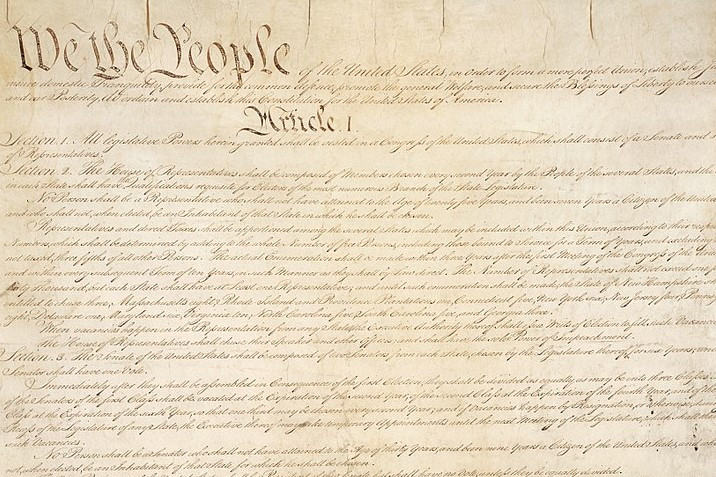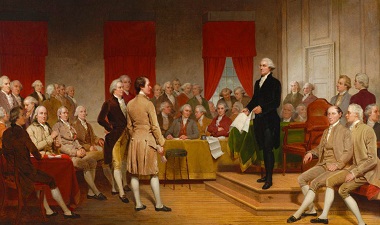The Separation of Powers
Dr. Yuval Levin of the American Enterprise Institute argues that the defense of liberty requires multiple answers to a fundamental political question: who rules?

In Federalist No. 47, in the course of justifying the basic structure of the newly proposed Constitution to his readers, James Madison made an extraordinary pronouncement:
The accumulation of all powers, legislative, executive, and judiciary, in the same hands, whether of one, a few, or many, and whether hereditary, self-appointed, or elective, may justly be pronounced the very definition of tyranny.[1]
The freedom of the American people, he suggested, depends less on how their leaders are chosen than on whether the different powers of government are divided among different people. Political legitimacy may well require representation, but the defense of liberty requires above all that there be more than one answer to the fundamental political question: who rules?
The means by which the Constitution addresses this need has come to be known as the separation of powers. The legislative, executive, and judiciary powers compose separate branches of the national government, described in separate A rticles of the Constitution. But this is no simple separation. In fact, the very complexity of the ever-evolving relations among the three branches of the national government has been an essential feature of both the structure and logic of the American system, and remains crucial to its capacity to secure the liberties of citizens.
The notion that there are three basic modes of governmental action has deep roots in the political tradition of the West. In his Politics, written in the fourth century BC, Aristotle identified lawmaking, the execution of the law, and the adjudication of disputes about its implications as the three core functions of government. But he did not insist they must be separated, because the freedom of the citizen was not his primary concern.[2] That emphasis on liberty reached the Framers of the Constitution through the classical-liberal thinkers they imbibed, perhaps most prominently Montesquieu, who, in his Spirit of the Laws, published in 1748, made an assertion much like Madison’s. When the powers of government “are united in the same person, or in the same body of magistrates,” Montesquieu wrote, “then there can be no liberty.”[3]
In the abstract, the case for this kind of separation as a vital safeguard of freedom is straightforward. If the people who make the law also decide how to enforce it and then resolve disputes about whether it was properly applied, then it is the will of those individuals, and not the authority of the law, that governs the society. Even if those all-powerful magistrates are elected, and genuinely represent the majority, there is no recourse when they act abusively or tyrannically. Concentrated power is inherently unaccountable.
The case for avoiding such concentration, moreover, is not only a matter of protecting liberty but also of recognizing the distinct characters of the different powers of government, and embodying them in different kinds of institutions. It is vital to see that, in the conception of politics advanced by our Constitution, there is not just one fungible commodity called “power,” which the different branches of our government divide among themselves. The different functions of government make for different modes of operation that are best expressed in different institutional forms.
The legislature frames and authorizes government action. It makes the laws that channel public power and allocate public resources. In a complex society like ours, this kind of framing work is necessarily the product of accommodation and compromise between different views and factions, and the work of the Congress is therefore necessarily plural: It is a work of many, and involves conciliation among them.
The executive, meanwhile, generally acts within the structures established by the laws that the legislature frames. The purpose of the office is action in the world, and its institutional design reflects that. The president applies the sorts of power given to him by Congress (and in some limited cases directly by the Constitution) to the particular circumstances our society confronts, and wields it in the moment to secure the nation and carry out its laws. He reacts to events, adjusts to pressures, and makes concrete choices among permissible options in complicated situations. Action like that is almost necessarily a singular endeavor, not a group activity, as to be carried off well it requires energy, boldness, steadiness, focus, and ambition.
The judiciary then steps in after laws have been framed and actions have been taken, and reviews them in response to cases and complaints to make sure that general rules have been applied appropriately in particular circumstances. It neither makes laws nor acts to execute them but assesses the behavior of others.
It is only a slight exaggeration to say that the Congress is expected to frame for the future, the president is expected to act in the present, and the courts are expected to assess the past. And the branches also represent different modes of legitimacy. The House of Representatives and (especially since the ratification of the 17th Amendment in 1913) the Senate are directly elected by the people, and their internal plurality makes them capable of representing the diversity of our society. The President is more indirectly elected, and his unitary office puts his own character front and center. The courts are appointed and kept shielded from the shifting winds of public opinion, in the hope of elevating learned judgment over popularity. Including these different answers to the question of who rules within one system while keeping them separated allows our Constitution to benefit from them all in different circumstances, and from the tensions between them.
But these internal tensions actually mean that the separation of powers can never be complete. Despite his bold assertion about the necessity of that separation, Madison acknowledged that some critics of the Constitution thought the document failed to separate the branches sufficiently. “One of the principal objections inculcated by the more respectable adversaries to the Constitution,” he wrote, “is its supposed violation of the political maxim, that the legislative, executive, and judiciary departments ought to be separate and distinct.”[4]
These critics had a point. While the Constitution does create three distinct branches of government to house the three distinct functions of government, it also intertwines those branches and involves them in one another’s work. Presidential appointments and treaties require the approval of the Senate, for instance, and all executive and judicial officers can be impeached and removed by Congress. The president can veto legislation and propose specific measures to Congress. Judges are appointed by the executive, if the Senate approves, and can halt or reverse some kinds of legislative and executive actions. The everyday work of the branches draws them constantly into one another’s business.
But there is a reason for that intertwining. It happens in part because the distinctions between the kinds of powers the branches exercise is not itself perfectly clean. “Experience has instructed us that no skill in the science of government has yet been able to discriminate and define, with sufficient certainty, its three great provinces the legislative, executive, and judiciary,” Madison argued in Federalist No. 37.[5] But more importantly, as he noted in Federalist No. 48, to achieve the primary purpose of the separation of these branches—which is the prevention of abuses of power and the defense of the liberties of citizens—it is actually necessary to intermix the branches a little at the margins. “Unless these departments be so far connected and blended as to give to each a constitutional control over the others, the degree of separation which the maxim requires as essential to a free government, can never in practice be duly maintained.”[6]
To work in that way, however, this mixing of authorities must be only marginal. Rather than give each branch a real share of the kind of work the others do, it gives each branch some modest means to restrain the others in their own domains, as a defensive measure. This is intended ultimately to preserve the separation between the branches and insist on the differences between them. As Madison put it in Federalist No. 51:
[T]he great security against a gradual concentration of the several powers in the same department, consists in giving to those who administer each department the necessary constitutional means and personal motives to resist encroachments of the others. The provision for defense must in this, as in all other cases, be made commensurate to the danger of attack. Ambition must be made to counteract ambition.[7]
The branches can’t be fully separate because, to serve the very purpose of the separation, they have to engage with each other—to resist and pressure each other.
In this sense, the separation of powers is the foremost example of a premise embodied by the entire constitutional framework: that a system of government is not a machine but an arrangement of people. Its work must consist of human interaction. It must be dynamic and durable, which means it has to somehow exist in constant tension with itself.
The separation of powers is therefore best understood not as an architectural element of our system but as a dynamic feature of it. And this is also how it protects the liberty of the citizen. Liberty is not a condition but a way of life. It can only be sustained by constant action. And the very precarity of the separation of powers—the fact that it is a source of constant tension and strife, of endless lawsuits, threats, and bargains—is precisely how it keeps our system limber. That this system is always threatening to fall over is how it keeps us always focused on maintaining its balance. That it has evolved with circumstances is how it has remained connected to its original purpose.
The tense and endless combat between the branches facilitates the everyday work of constitutionalism. Without it, our government could neither meet our society’s needs nor secure the people’s freedom. The absence of a functional, complex, always shifting separation of powers could justly be pronounced the very definition of tyranny.
Dr. Yuval Levin is Beth and Ravenel Curry Chair in Public Policy; Director of Social, Cultural, and Constitutional Studies, American Enterprise Institute.
___________________________
[1] Federalist 47
[2] Aristotle, Politics, Book IV, 1297b-1298a
[3] Montesquieu, The Spirit of the Laws, Book XI, Chapter 6
[4] Federalist 47
[5] Federalist 37
[6] Federalist 48
[7] Federalist 51







